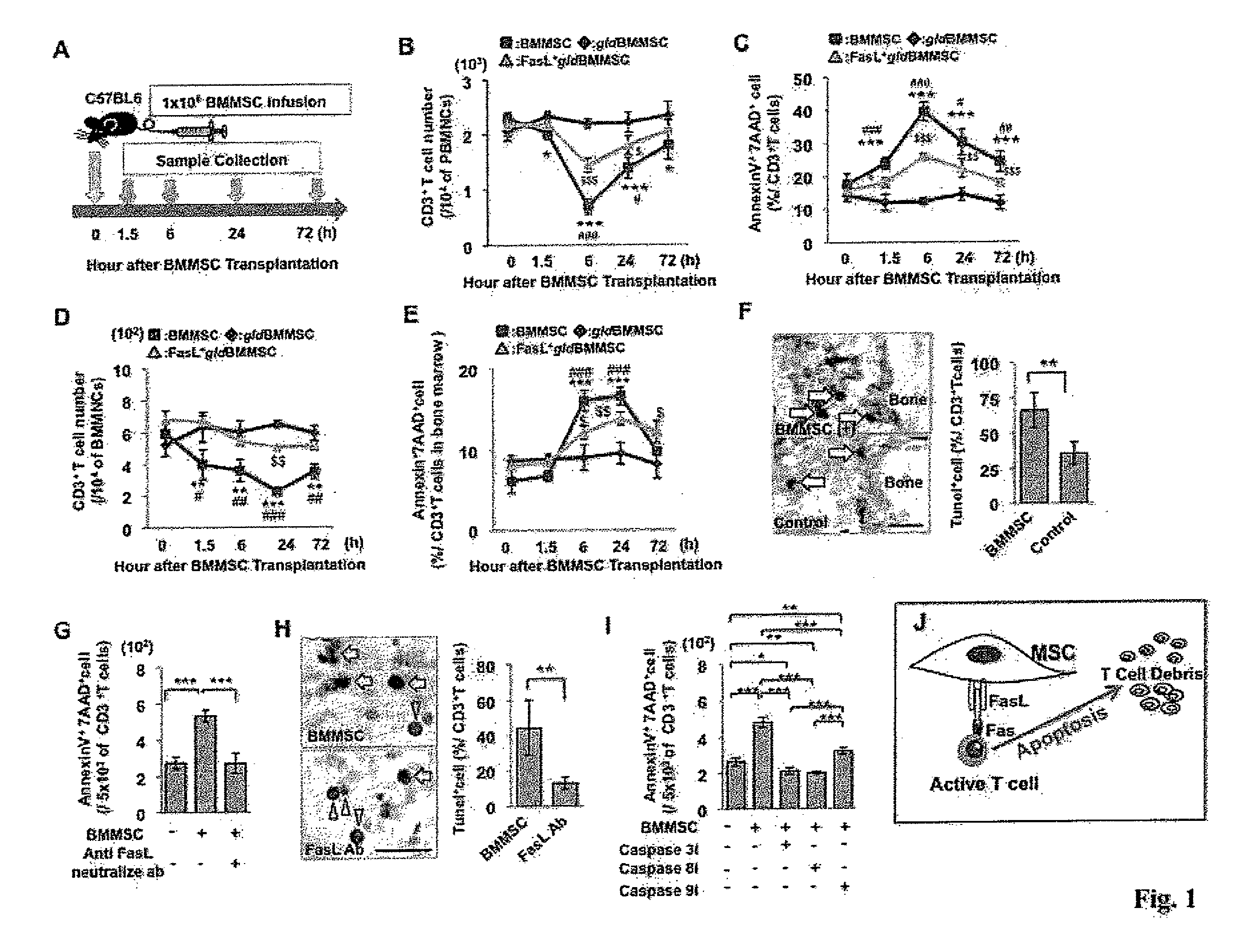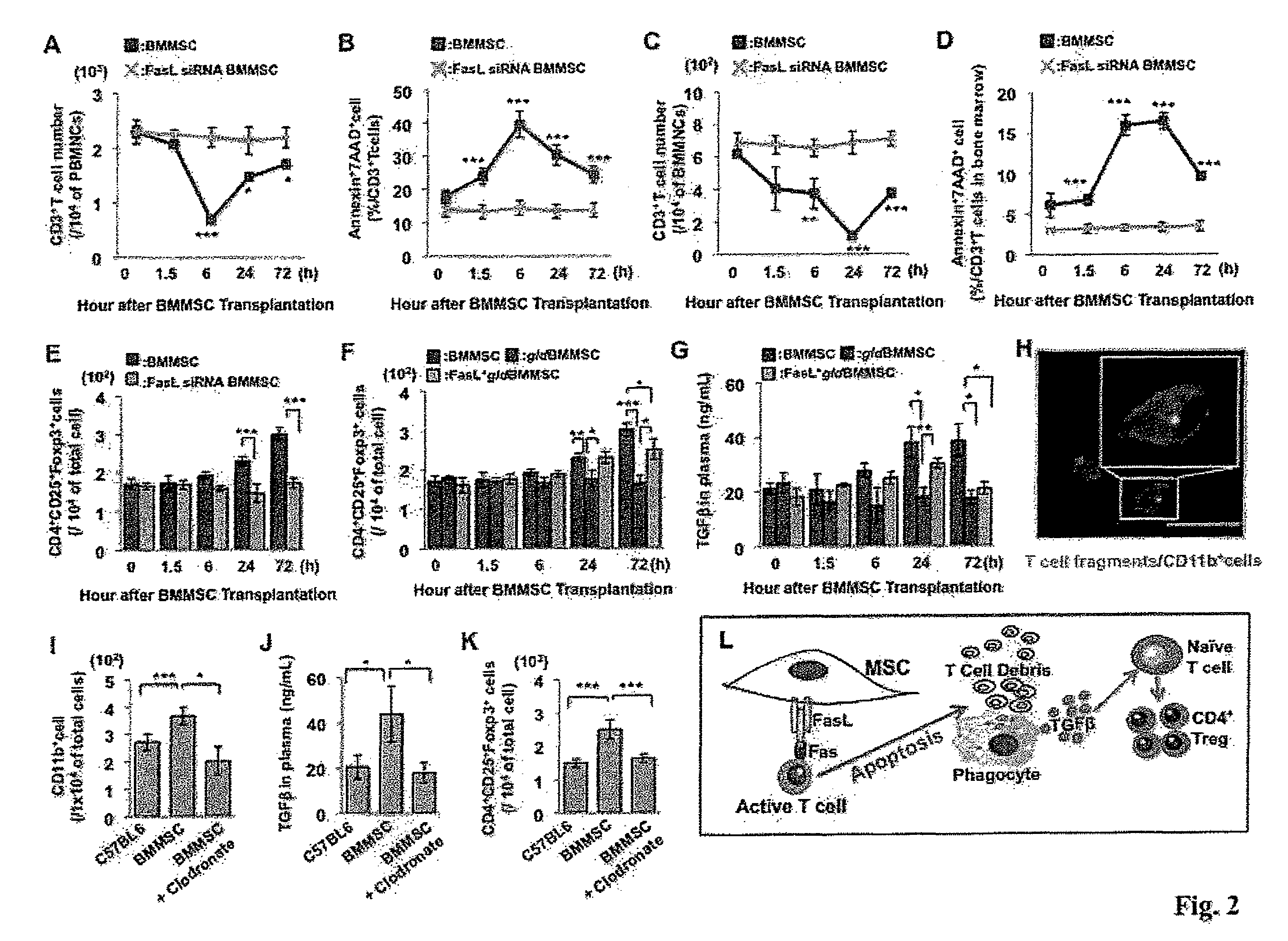Compositions and Treatment Methods for Mesenchymal Stem Cell-Induced Immunoregulation
a technology of mesenchymal stem cells and immunoregulation, which is applied in the field of compositions and treatment methods of mesenchymal stem cell-induced immunoregulation, can solve the problems that the underlying mechanisms of msc-based immunoregulation are not fully understood, and achieve the effects of alleving and/or ameliorating the symptoms of the diseas
- Summary
- Abstract
- Description
- Claims
- Application Information
AI Technical Summary
Benefits of technology
Problems solved by technology
Method used
Image
Examples
example i
Fas Ligand (FasL) in BMMSCs Induces T Cell Apoptosis
[0131]BMMSCs from C57BL6 mice and FasL-mutated B6Smn.C3-Faslgld / J mice (gldBMMSC), along with FasL transfected gldBMMSCs (FasL+gldBMMSC) were injected into normal C57BL6 mice (FIG. 1A). Similar to normal BMMSCs, FasL null gldBMMSCs express mesenchymal stem cell markers and possess multipotent differentiation capacity (data not shown). Peripheral blood and bone marrow samples were collected at 0, 1.5, 6, 24, and 72 hours after BMMSC transplantation for subsequent analysis (FIG. 1A). Allogenic BMMSC infusion reduced the number of CD3+ T cells and increased the number of apoptotic CD3+ T cells in peripheral blood and bone marrow, starting at 1.5 hours, reaching the peak at 6 hours and lasting until 72 hours post-transplantation (FIGS. 1B-1E). In order to compare syngenic and allogenic BMMSCs, we found that BMMSCs derived from a littermate are same as allogenic BMMSCs in inducing T cell apoptosis (FIGS. S2A-2G). Meanwhile, infusion of ...
example ii
FasL is Required for BMMSC-Based Immune Therapies in Both Tight-Skin (Tsk / +) Systemic Sclerosis and Inductive Experimental Colitis Mice
[0136]To further study the therapeutic mechanism of BMMSC transplantation, two mouse models, genetic tight-skin (Tsk / +) systemic sclerosis and inductive experimental colitis, were used to evaluate the therapeutic effect of BMMSC transplantation. Allogenic normal BMMSCs or gldBMMSCs (1×106) were systemically transplanted into Tsk / + systemic sclerosis mice (Green et al., 1976) at 8 weeks of age, and samples were harvested at 12 weeks of age for further evaluation (FIG. 3A). The BMMSC-transplanted group showed significant reduction in the number of CD3+ T cells and corresponding elevation in the number of apoptotic CD3+ T cells in peripheral blood from 6 to 72 hours post-transplantation (FIGS. 3B and 3C). On the other hand, FasL− / − gldBMMSC transplantation failed to induce CD3+ T cell apoptosis (FIGS. 3B and 3C).
[0137]Tsk / + mice showed an increase in th...
example iii
Fas is Required for BMMSC-Mediated Therapy by Recruitment of T Cells
[0139]In addition to the production of FasL, the isolated BMMSCs used herein also express Fas (FIG. 13A). To examine whether Fas plays a role in BMMSC-based immunotherapies, we infused Fas− / −BMMSCs, derived from C3MRL-Faslpr / J mice (lprBMMSCs), to C57BL6 mice and found that Fas− / − lprBMMSCs failed to reduce number of CD3+ T cells or elevate the number of apoptotic CD3+ T cells in peripheral blood and bone marrow (FIGS. 5A-5D). As widely used autoimmune disease models, FasL null gld and Fas null lpr mice showed a significantly increased number of CD62L−CD44+ activated T cells and elevated ratio of Th1 / Th2 and Th17 / Treg (data not shown). In addition, both gld and lpr T cells showed reduced response to CD3 and CD28 antibody stimulation when compared to the control T cells (data not shown). It appeared that gld and lpr BMMSCs showed similar colony forming capacity, multipotent differentiation, and surface molecular expr...
PUM
 Login to View More
Login to View More Abstract
Description
Claims
Application Information
 Login to View More
Login to View More - R&D
- Intellectual Property
- Life Sciences
- Materials
- Tech Scout
- Unparalleled Data Quality
- Higher Quality Content
- 60% Fewer Hallucinations
Browse by: Latest US Patents, China's latest patents, Technical Efficacy Thesaurus, Application Domain, Technology Topic, Popular Technical Reports.
© 2025 PatSnap. All rights reserved.Legal|Privacy policy|Modern Slavery Act Transparency Statement|Sitemap|About US| Contact US: help@patsnap.com



